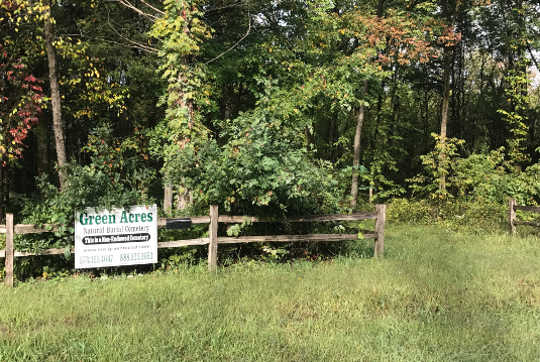
Green Acres natural burial cemetery in Boone County, Missouri. Photo credit: Grey Wanderer, CC 3.0
The basic tenets of environmentally friendly living are now being posed for environmentally friendly dying. Green burial is all about sustainability and developing funeral practices that support and heal nature rather than disrupt and harm it.
One key to the natural-burial movement is green or natural cemeteries, much like the town churchyard and farmer’s field where bodies were once buried in a shroud or biodegradable box. Today, modern cemeteries have almost completely replaced these practices, but the good news is that traditional cemeteries are on the decline. They are losing business to cremation, and with green burials on the rise, green cemeteries are appearing to accommodate them.
However, for many, there’s something appealing about the return to family cemetery plots on family land. Of course, this practice enjoys a very, very long tradition in America. It’s what families did for generations — burying loved ones on the family property.
Green Burial Grounds and Cemeteries
A green cemetery doesn’t try to control nature with pesticides, pristine lawns, nonbiodegradable caskets, and concrete burial vaults. Green burial grounds allow the physical world to bloom and blossom; they encourage the indigenous shrubs, wildflowers, woodlands, and grasslands that support the area’s birds and other wildlife.
Of course, you may or may not be able to find a genuinely green cemetery where you live. However, some traditional cemeteries allow certain green practices, so always ask. For instance, according to the National Funeral Directors Association, “The use of outer burial containers or vaults is not required by federal or state law, but is required by many cemeteries. In many rural areas, vaults or grave liners are usually not required.” The reason traditional cemeteries usually require a vault is to keep their graveyards from developing a wavy-gravy look. Once biodegradable caskets decompose, the earth will settle, leaving depressions.
The Three Categories of Green Burial Grounds
The Green Burial Council distinguishes three types of green burial grounds: hybrid, natural, and conservation. Here is their official definition of each:
- Hybrid Burial Grounds are conventional cemeteries offering the option for burial without the need for a vault (partial, inverted, or otherwise), a vault lid, concrete box, slab, or partitioned liner. Hybrid Burial Grounds shall not require the embalming of decedents and must allow for any kind of eco-friendly burial containers, including shrouds.
- Natural Burial Grounds require the adoption of practices/protocols that are energy-conserving, minimize waste, and do not require the use of toxic chemicals. A Natural Burial Ground achieves GBC certification by prohibiting the use of vaults (partial, inverted, or otherwise), vault lids, concrete boxes, slabs, or partitioned liners, and by prohibiting the burial of decedents embalmed with toxic chemicals, as well as by banning burial containers not made from natural/plant-derived materials. It must have in place a program of Integrated Pest Management (IPM) and be designed, operated, and maintained to produce a naturalistic appearance, based on use of plants and materials native to the region, and patterns of landscape derived from and compatible with regional ecosystems.
- Conservation Burial Grounds, in addition to meeting all the requirements for a Natural Burial Ground, must further legitimate land conservation. It must protect in perpetuity an area of land specifically and exclusively designated for conservation. A Conservation Burial Ground must involve an established conservation organization that holds a conservation easement or has in place a deed restriction guaranteeing long-term stewardship.
If there is not a natural or conservation burial ground close to you, a hybrid burial ground may be easier to find. These are standard cemeteries that typically have an area set aside that does not require a casket or grave liner. Cemeteries all over the country are considering and opening sections for natural burial spaces, so never hesitate to pick up the phone and ask your local cemetery directly.
As you research possible cemeteries, you will find some graveyards are set in very contemporary, natural environs. Williamsburg Cemetery in Kitchener, Ontario, boasts beautiful wetlands, encourages bird-watching, and has natural walking trails and ponds; this cemetery has fully integrated their burial areas in a natural-looking garden. But despite this serene and reflective exterior, all gravesites require liners, and therefore this cannot be considered a hybrid, natural, or conservation cemetery.
What If You Already Own Cemetery Lots?
As I’ve said, most local cemeteries require the use of a burial vault to maintain flat ground in their memorial park. However, ask if the cemetery will allow for the burial vault to be placed upside down, over the top of the casket. This helps ensure two things: The casket can be as close to the ground as possible, so the deceased will eventually rejoin with the earth, and yet this still provides a suitable surface for maintaining level ground.
Obviously, if you are paying for a grave space at a green burial cemetery or hybrid cemetery, they have you covered. You’ll be able to have a green burial, and you won’t need to worry about the logistics, as you do with a backyard burial. Still, if using your own John Deere and making your own hole in the ground is important to you, you need to find a different location than a traditional cemetery.
Backyard Burials
A backyard burial encompasses burying a person on residential property, or land that is privately owned. This precludes any land that has been endorsed as an actual cemetery. Most bodies are buried in established cemeteries, but burial on private property may be possible. Laws vary not only state to state but county to county; it’s most accepted and typical in rural settings.
If you are considering a backyard burial, think carefully about what it may mean for the property itself and the person who owns it (which may be yourself). All other issues aside, burying someone on private land impacts the future sale of that property. In addition, however remote the concern may be, you should consider how you’d feel, and what you would do, if your deceased loved one resided on property that you no longer owned.
For instance, depending on the type of property, the land could become fundamentally unmarketable to succeeding buyers if the interred body isn’t relocated, and even then, a stigma might remain that makes selling the tract difficult. Not only that, exhuming and transferring a body is expensive. However, even if this isn’t done and the property is sold, family members and others won’t necessarily have access to the property to visit the gravesite anymore. Perhaps most unsettling of all, what if the land is sold and developed for a different use, one that rattles the bones in their resting place?
In light of these issues, reflect on all the possible outcomes before committing to creating a private burial ground on residentially zoned property. Further, don’t make this decision without legal guidance and consultation, and begin the planning process well in advance. It can involve a lot of paperwork.
But do not let these cautions discourage you if this is your dream or the final wishes of someone you love. I am truly finding that people are increasingly embracing the mindset of ashes to ashes and dust to dust, and many families I have served would not have done it any other way.
Legal Considerations with Residential Burials
Regarding the future sale of the property, it is the responsibility of the property owner to disclose if human remains are buried anywhere on the land. The owner must agree to maintain and provide records of the disposition on the property, and agree to disclose the disposition of human remains upon sale of the property.
As for the legality of the burial itself, the property will be governed by local laws, so consult with your local health authority prior to planning the burial. Personally, I run every address by my county’s zoning and planning department just to make sure. For this guidebook, I hesitate to generalize, as the rules vary by county and town. In essence, private property burial is often allowed, but each area has slightly different requirements.
One thing you must do, no matter whose name is on the property’s deed, is to get the written consent of any mortgage or lien holders. As well, you must meet all state requirements for the completion of the death certificate and acquire all transport permits or other required documentation.
Home burials in Oregon must meet certain environmental standards. For instance, land in which surface water or ground drainage enters other water sources — like a pond, stream, well, tributary, and so on — cannot be used for burial purposes without written approval from the Oregon Department of Environmental Protection.
I’ve read other regulations that stipulate that private burial sites “should be 150 feet from a water supply, 100 feet from a drilled well, and 25 feet from a power line....It’s also a good idea to bury at least 20 feet from the setback on your property.” Finally, even when you can create a family burial ground on your own land, you cannot charge money for burial rites. Most people wouldn’t, but this is just an example of the many issues and concerns you should investigate before moving forward.
Tip: Mother Nature Network offers this excellent advice: “If you bury a body on private land, you should draw a map of the property showing the burial ground and file it with the property deed so the location will be clear to others in the future.”
Burial at Sea
Burial at sea is a disposition method that releases a deceased body into the ocean, so that it sinks and decomposes naturally. A burial at sea can be considered a green burial if, as with any green burial, it does not involve traditional embalming or containers made of steel, concrete, or other nonbiodegradable materials.
Arranging a burial at sea is possible for anyone, no matter how far from the water you live. However, it requires a boat, and if you don’t have one, you’ll need to contract one. Also, a burial at sea (as well as spreading cremated ashes at sea) must follow a different set of rules than for burials on land.
The Environmental Protection Agency (EPA) oversees US laws and regulations for burials at sea. The general permit is published in the federal regulations (available online), and the rules mandate that the site of the water interment be three nautical miles from land and at a depth of at least six hundred feet. Furthermore, the rule requires that “all necessary measures shall be taken to ensure that the remains sink to the bottom rapidly and permanently.”
New England Burials at Sea is a Massachusetts company that can be hired for this service, and they also provide help and information for families interested in this option. I had a lovely email exchange with the owner, Captain Brad White, who said voyages take about forty-five minutes to reach the desired location, approximately three miles off the coast at an ocean depth of six hundred feet.
Performing a green burial at sea is possible without the help of a contracted service. If you wish to do so, consult the EPA’s “Burial at Sea” website, and keep these two important steps in mind:
- The EPA must be notified within thirty days of a full-body burial at sea with the following details: date, time, place, name of the deceased, and person responsible for burying the body at sea.
- Care needs to be taken to ensure that the body sinks to the ocean floor. Either weigh down a biodegradable shroud, or drill a natural wood coffin with enough holes that it will take on water (the EPA website has instructions).
Excerpted from the book The Green Burial Guidebook.
Copyright ©2018 by Elizabeth Fournier.
Printed with permission from New World Library
www.newworldlibrary.com.
Article Source
The Green Burial Guidebook: Everything You Need to Plan an Affordable, Environmentally Friendly Burial
by Elizabeth Fournier, “The Green Reaper”
 Funeral expenses in the United States average more than $10,000. And every year conventional funerals bury millions of tons of wood, concrete, and metals, as well as millions of gallons of carcinogenic embalming fluid. There is a better way, and Elizabeth Fournier, affectionately dubbed the “Green Reaper,” walks you through it, step-by-step. She provides comprehensive and compassionate guidance, covering everything from green burial planning and home funeral basics to legal guidelines and outside-the-box options, such as burials at sea. Fournier points the way to green burial practices that consider both the environmental well-being of the planet and the economic well-being of loved ones. (Also available as a Kindle edition.)
Funeral expenses in the United States average more than $10,000. And every year conventional funerals bury millions of tons of wood, concrete, and metals, as well as millions of gallons of carcinogenic embalming fluid. There is a better way, and Elizabeth Fournier, affectionately dubbed the “Green Reaper,” walks you through it, step-by-step. She provides comprehensive and compassionate guidance, covering everything from green burial planning and home funeral basics to legal guidelines and outside-the-box options, such as burials at sea. Fournier points the way to green burial practices that consider both the environmental well-being of the planet and the economic well-being of loved ones. (Also available as a Kindle edition.)
Related Books
About the Author
 Elizabeth Fournier, affectionately called “The Green Reaper,” is the author of The Green Burial Guidebook: Everything You Need to Plan an Affordable, Environmentally Friendly Burial. She is owner and operator of Cornerstone Funeral Services, outside of Portland, Oregon. She serves on the Advisory Board for the Green Burial Council, which sets the standard for green burial in North America. She lives on a farm with her husband, daughter and many goats. Find out more about her work at www.thegreenreaper.org
Elizabeth Fournier, affectionately called “The Green Reaper,” is the author of The Green Burial Guidebook: Everything You Need to Plan an Affordable, Environmentally Friendly Burial. She is owner and operator of Cornerstone Funeral Services, outside of Portland, Oregon. She serves on the Advisory Board for the Green Burial Council, which sets the standard for green burial in North America. She lives on a farm with her husband, daughter and many goats. Find out more about her work at www.thegreenreaper.org
























